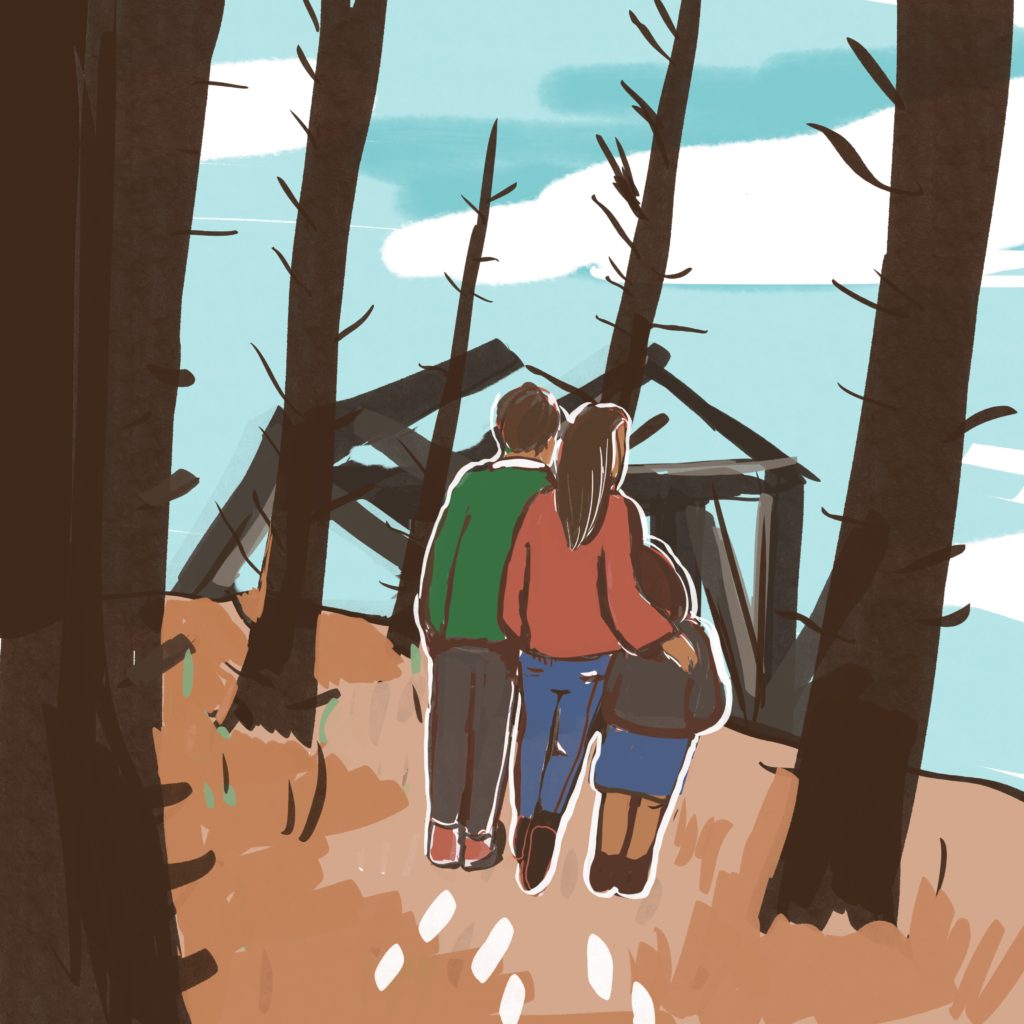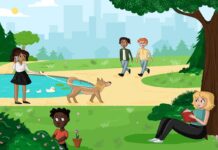On May 16, 2011, most of the 7,000 people who lived in Slave Lake, Alberta had to be evacuated due to a fire that ripped through the town. Aidan Antony was one of them. At 12 and a half years old, he had to move with his family to Edmonton to be safe.
“In terms of the evacuation, it was very hectic and very last minute,” the third-year biomedical and electrical engineering student recalled.
“The highway north of the town was closed due to the fire so the only other two options were to the south and to the west,” he said. “It took us a very long time to arrive in Edmonton but we did make it there safely.”
“Honestly, it was very miraculous that there were no fatalities during the fire as it was complete chaos, due to very little information being given [out] along with the fire being so close to the road.” – Aidan Antony, third-year engineering student at Carleton.
Julia Belmonte had to be evacuated twice in about twenty years, from her home in Summerland, B.C., But the fourth-year criminology student said she has been on alert “more times than I can count.”
These experiences are not isolated. Wildfires happen throughout Canada and around the world, from the Amazon to Russia to the Congo.
Currently, wildfires are burning around the world and at an alarming rate. In total, Canada has seen 3,873 reported wildfires this year and have burned over 1.8-million hectares of land – including places like British Columbia, Alberta, and Yukon.
Causes and Concerns
Wildfires can occur for a number of reasons. There are natural causes like dry weather conditions and lightning, or industrial causes such as sparks from electrical polls and railway tracks. Fires can also be man-made, which was the case in Slave Lake.
Natural fires are an important part of the forest ecosystem because they help some species of trees grow. Without natural fires, there is an increased risk of more dangerous fires, as old, dead, and dry vegetation builds up, said Michael Drescher a professor from the faculty of environment at the University of Waterloo.
“For a long time in Canada of course, we have had fire suppression activities which ironically lead later on to higher risk of wildfires and more intense wildfires—because if you stop forests from occasionally having small fires, they grow and grow and grow so when they eventually burn, they really burn,” he said.
These natural fires account for about 50 per cent of the land burned in Canada nationally according to a report produced in 2013 by B.J. Stocks Wildfire Investigations Ltd.
Uninhibited flames incited by extremely dry weather conditions can consume millions of acres of land at accelerated speeds and can destroy everything—trees, homes, animals, and humans— that crosses their path.
These fanning flames travel up to 22 km an hour and can easily outdistance the average human within minutes.
But when do man-made fires start to become a concern for the environment? According to Drescher, it comes down to whether the fires are large scale or small scale.
“Man-made fires have been around as long as people have been around,” he said.
However, the main problem is when the scale of the fire increases, more carbon gets released into the atmosphere, which is bad for the environment.
“The problem is the CO2 that gets released in the forest. The more forests go, the less carbon is stored,” said Drescher.
Canadians forests have been losing more carbon than they are retaining since the beginning of the century, which is a cause for concern said Drescher.
“Most forests can recover from a fire but when there are repeated fires or disturbances or there are fires that are on too large of a scale, they get to a point where the system of the forest can change state where it no longer stays a forest. It becomes a grassland or dryland,” he said.
People are definitely concerned.
“I’m terrified. I feel like the reality of climate change hasn’t hit a lot of people because they haven’t personally experienced anything so they don’t realize,” Ayah Gahelrasoul, a second-year student studying neuroscience and mental health said.
The effects of wildfires are widespread, said Antony who has seen bears appearing in his backyard.
“This summer there was a dramatic increase in bears that were entering town [sic] and one of the theories on why there were so many bears was due to the fires destroying their habitats and areas where they eat berries, fruits, and things like that,” he said.
“Since the fires are destroying their resources they now have to seek new food sources and those sources are now coming from peoples’ backyards.”
Putting out the flames, burning the economy

Fighting wildfires requires a lot of resources and tools. According to data from Natural Resources Canada, wildland fire management agencies invested between $800-million to $1.4-billion annually over the last 10 years in fire management expenditures which can include fire preparedness, mitigation, response, and recovery costs. This is predicted to increase as fire seasons get longer.
“We have a core season that runs from April to November,” said Erika Berg, information officer at B.C. wildfire service.
Money has been invested in building response teams who fight the fires, as well as a backroom of logistics staff and new equipment, said Berg.
A variety of equipment is required for fighting wildfires “depending on the characteristics of the wildfire and landscape,” she added. Everything from hoses to bulldozers to simple axes may be required depending on the situation.
Wildfires —simply put—are costing the economy. Overall fire management expenditures have risen about $150-million per decade since 1970 and costs of wildfire exceeded $1-billion for the past six of 10 years according to data from Natural Resources Canada.
“Budgets we have for firefighting are unsustainable, every year the budgets for wildfires are surpassed,” said Drescher.
Slave Lake was devastated by the fire in 2011. 33 per cent of the town burned, 372 properties were destroyed, and 52 were damaged. The total insurance cost exceeded $700 million.
Antony’s family was one of the lucky ones.
“My family’s house fortunately survived the fire,” he said. But some of his extended family weren’t so lucky.
“My aunt and uncle’s [house] was on the north side of the park and it unfortunately burned in the fire. They were away from town on a trip so they ended up losing everything,” he added.
Wildfires also hurt the forestry sector, which is already in an economic downturn, according to Drescher. Forestry can contribute to fighting climate change, but the lack of proper management makes it near impossible.
“It’s unfortunate because forestry sectors could be one of the contributors to climate change mitigation and adaptation–especially mitigation because we could use a forest strategy that’s modified to produce renewable wood-based products as alternatives to oil-based products we are currently using, for instance,” he said.
Changing Climate, Bigger fires

Wildfires are part of the natural ecosystem of forests, but a changing climate creates more sensitive forests, bigger fires, and problems for Indigenous communities that depend on the forests.
Currently, Indigenous tribes residing in the Amazon are being severely impacted by extreme wildfires. These fires have a direct impact on their means for survival and can also limit their ability to practice their cultures and traditions freely.
“If on a large scale these forests were to be destroyed or get into a dynamic where they just don’t have any more of the biophysical conditions that allow them to exist, the forest would just disappear and the Indigenous populations would disappear as well with them,” Drescher said.
Here in Canada, Berg said the changing climate creates more uncertainty in the weather conditions, which extends the fire season.
“I think a common misconception is that that when August is over wildfire season is over,” she said. “We are constantly assessing those conditions and whether a wildfire season isn’t over just because a date has come, we constantly have to look at and be aware of changing weather trends.”
Drescher said increased wildfires in Canada can be pointed to climate change.
“Climate change can mean an increase in extremity, it doesn’t necessarily mean things will simply get drier or wetter.”
“But it just might be the cycles between dry and wet may be more pronounced.”
Antony shared similar concerns. “When people think of climate change they just think hotter weather but climate change can look like many things, bears entering town for instance, is a result of climate change,” he said.
Due to a wetter June and July, British Columbia had a quieter fire season this year than usual which has enabled the province’s fire services to help other areas such as Alberta, Yukon, and Alaska, said Berg.
“This year B.C. wildfires has responded to 781 wildfires whereas if you compare it to last year, where we had over 2000 wildfires and even greater is the number of hectares burned,” she said.
“This year the number of hectares burned was just over 21,000, and last year hectares burned were into the millions—1.3-million to be exact.”
“We are just thanking mother nature for that,” she added.
Concerns and Hopes for the Future

“We need to be more aware because it honestly feels like the world is ending,” said Gahelrasoul. “There is so much going on with these natural disasters, tornadoes, hurricanes, wildfires and it’s getting out of hand.”
Professor Drescher shared similar concerns.
“It is probably an illusion to think that we can just cut down all these forests and that there will be no response,” he said.
“These systems [forests] are dynamic, they have a certain state that they took on because the conditions were right, and if we are now changing the conditions, the system might disintegrate and we don’t know how far we can push the system before that happens,” Drescher added.
Putting pressure on political leaders and taking action can help create change, said Drescher.
“Most people in Canada are concerned about climate change but that concern often does not get translated into action,” he said. “People worry but they do not act and it’s quite difficult to understand why that it is, what is holding them back.”
People have already begun to take action by putting pressure on political leaders. The global climate strike will happen on Sept. 20 and 27, with a UN climate summit on Sept. 23.
Drescher is optimistic that the leaders will listen to the people.
“I’m positive that political leaders will initiate change, it’s just a matter of people and populations as a whole taking a stance on climate change and taking political action by acting.”
Graphics by Sara Mizannojehdehi.






